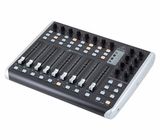This is my first controller surface with motorized faders, so bear this in mind when reading this review.
Total: 5/5 stars. For the price, it's a very enticing offer. 9 motorized faders, 16 push encoders, 38 buttons, and two layers doubling possible assignments. I was torn between this and the normal X-Touch, but I opted for this one, the Compact, since it's fully programmable, and has the extra 8 encoders on the side that allow me to control more parameters simultaneously.
Handling: 4/5 The unit is quite bulky. If it's not placed on a lower lever than the desk (where one would put the computer keyboard for example) it's not easy to see the encoders' ring LEDs, because the unit is quite tall too.
Features: 5/5 I give it a 5 out of 5, because of aforementioned programmability and the extra 8 push encoders.
Quality: 4/5 Going strong after about 3 months, although some encoders were more "loose" than the others, right out of the box. This is not to say that encoders do not click with authority, or that they have started to skip - no, everything works fine. It's just that not all 16 encoders are 100% consistent in feel. But I'm being overly picky here.
So. How I use it. With Cubase 12.
I downloaded the editor application. I assigned whatever messages I felt right in the X-Touch Editor (e.g. pitch bend for faders, notes for buttons, CC inc/dec for encoder twists, notes for encoder pushes, I saved these presets on my PC, I dumped them to the hardware unit.
***NOW here is a quirk. If I just load Cubase after powering up the Compact, Cubase doesn't want to work with it, something's off. HOWEVER, if I just load the X-Touch Editor application, and later enter Cubase, everything works perfectly. Just mentioning this, as it made an impression to me.***
After programming the Compact itself, it's a breeze to build a MIDI Remote in Cubase 12. Of course touch awareness for the faders is not quite there yet, but that is Cubase's business and not Compact's. (Of course one could just use the Compact in MC mode through the Generic Remote for traditional MCU implementation, in that case touch works just fine. Personally I just use the MIDI mode and abuse the Automation Write Button, by assigning it to each fader's touch trigger.)
Eventually, using the MIDI remote and devising a clever set of remote pages, allows this unit to control - with GREAT ease - at least 41 plug-in or instrument parameters (16 encoders, 16 pushes, 9 faders), sends, EQs, regular banks of channel volumes and pans, you name it. Imagination and clever design of the pages so that they allow natural workflow is the limit here, and the Compact is an excellent canvas.
(It's worth noting that when using Cubase's MIDI Remote, selecting a channel in Cubase will automatically have the Compact go to the proper fader Bank, unlike traditional MCU implementation.)
I was putting off the purchase of the Compact for some time, trying to persuade myself that:
a) I don't really need it.
b) I might run in insurmountable setup problems.
c) Quality might not be so great.
After a long time, I finally decided to buy it and:
a) Sure, I don't really need it, but it allows me to work much faster and enjoyably. If someone took it away from me right now, I would miss it.
b) It was extremely straightforward to set up in MIDI mode.
*Of course it took a minimum amount of effort to program what I needed in the device, and Cubase. I could have used MC mode for zero-effort control of Volume-Pan-Rec Enable-Mute-Solo-Select if I wanted instead.*
c) Quality is fine really, and Thomann's 3 year warranty has put me completely at ease.
I would easily recommend the Compact to anyone who wants an affordable controller with motorized faders and 16 push encoders and who doesn't care for displays, timecode and the traditional MCU layout.


